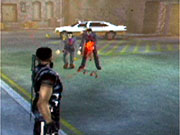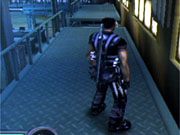We're starting to see a new evolution in the long-running trend of movie-licensed games. It hasn't spread too widely just yet, but it offers an alternative for publishers hoping to get a movie game on shelves when people are actively thinking about that movie. Instead of pushing games out the door within a week or two of a movie's theatrical release, some publishers are now starting to time their game releases to coincide with a film's release on DVD. In theory, Blade II for the PS2 and Xbox is among the first games to try to catch prospective purchasers while they're already out purchasing the movie. One thing that hasn't changed, unfortunately, is that most games based on movies are still little more than dreary, lifeless renditions of the films upon which they are based, usually failing to please both fans of the source material and fans of gaming, in general. So while Blade II may be on the cutting edge of simultaneous-release marketing, it otherwise sticks to the well-worn path beaten by many poor movie-based games before it.

Before Wesley Snipes made him popular, Blade got his start in comic books. The character is a special kind of vampire known as a daywalker--one who has all of the strengths of your basic vampire, yet doesn't explode when struck by sunlight or other similar antivampire weaponry. Blade and his human friend, Whistler, who's a gunsmith, are on a crusade to rid the world of vampires. The duo is simple: Whistler makes the weapons and Blade uses them. While the game is timed to release alongside the second Blade film, it has little to do with the actual Blade II movie. Only a few small elements of the story, a couple of weapons, and some overused catchphrases serve to connect the game to the film it's supposedly based on.
With few exceptions, the objectives in Blade II are basically the same from level to level: You want to get from point A to point B. Standing in your way are locked doors and a mess of vampires. Opening the locked doors requires you to run around and find switches or other, similar door-opening items. Fighting can be done hand-to-hand or with one of the weapons from Blade's arsenal. Hand-to-hand combat is handled using the trendy 2002 twist on third-person action games--the right analog stick lets you attack in any direction, like in Bruce Lee. You have to tap out your attacks fairly slowly, though, to get combos going. You start out unarmed, but earning points in levels unlocks the game's weapons fairly quickly. The pistol is easy to use, and targeting boxes appear around foes when you've locked on. The shotgun is, like most shotguns, good up close but slow to respond. The glaive is a spinning boomerang-like weapon that can take out multiple foes at once. Unfortunately, it takes quite a long time to charge up, making you an easy target for some dunderheaded enemies to run up and knock you out of your charging phase. UV grenades take out all the basic enemies in the vicinity with a blinding flash of light.
Fighting with foes also slowly charges up your rage meter. When the meter is full, you can activate a rage mode that lets you use Blade's sword to hack up enemies, cars, and anything else that gets in your way. Sometimes you'll trigger special kill animations, such as one where Blade grabs an enemy in a headlock and drives a stake into his head or one where he plants two pistol shots into the enemy's chest, making him explode in Blade's hands. The concept is cool, but the constant repetition of these scenes, often combined with one of Blade's catchphrases delivered in a monotone by some actor other than Wesley Snipes, makes the fact that you can't skip past them all the more annoying.
The control in Blade is rather stiff. Moving and turning is all done with the left analog stick, and it's sometimes difficult to turn sharply while moving. You can strafe side to side with a button press, but Blade strafes incredibly slowly, making it a basically useless maneuver. The jump move is a gigantic flying forward flip that can't be controlled in-flight and, if used to jump from a ledge, has a nasty recovery time that's apparently just for show, allowing Blade to do the familiar "land on one knee and fist, look ahead, stand up, and start moving" motion that you've seen in the movies.
Blade II also has some of the worst enemy AI so far this year. Enemies are content to stand around and ignore Blade until you run right up to them. Killing enemies on a crowded dance floor doesn't even wake nearby enemies out of their dancing animations, and if you're using your pistol, you can usually kill every enemy before the others in the room are even aware of your presence.

Graphically, Blade II doesn't really do anything to stand out. The character models aren't particularly good, and the way Blade's chin tends to clip through his puffed-out chest during cutscenes just seems sloppy. There are some decent effects, such as the blur used when going into rage mode, but the animation behind it all seems just as stiff as the game's control. As far as audio is concerned, the game really blows it. The accompanying movie has a pretty solid techno/rap soundtrack that would have been a lot better suited here than the dull, repetitive "game techno" found throughout. The pistol fire sounds extremely flat, and the enemies repeat the same two or three phrases throughout the game. The voice actors for Blade and Whistler sound somewhat close to their movie counterparts, for what it's worth, though that's not saying much.
If you find yourself out shopping for some Blade II-related items, take a pass on the game and stick to the movie. Poor AI, dull design, and lackluster presentation all add up to make Blade II a game that you should definitely skip.